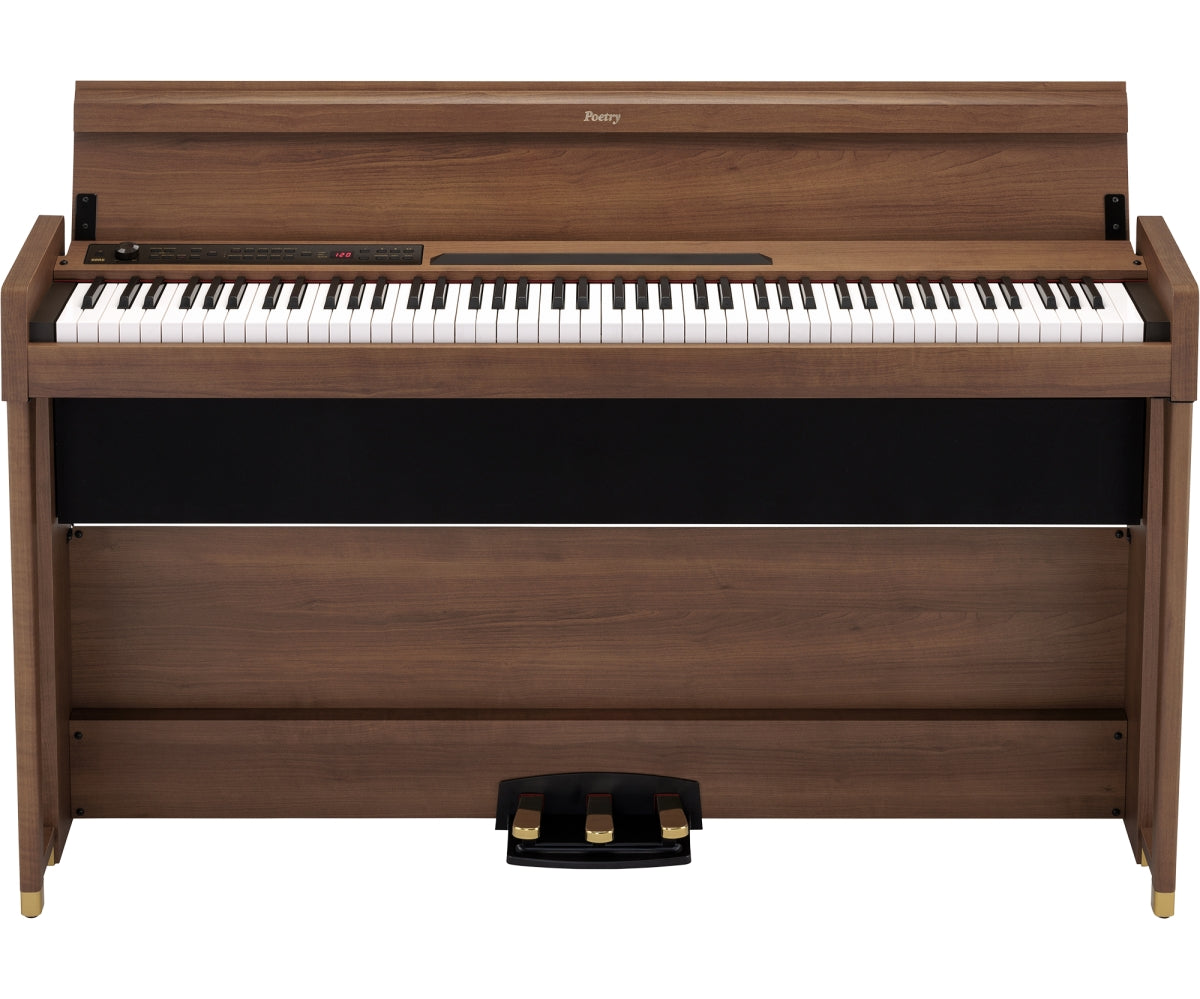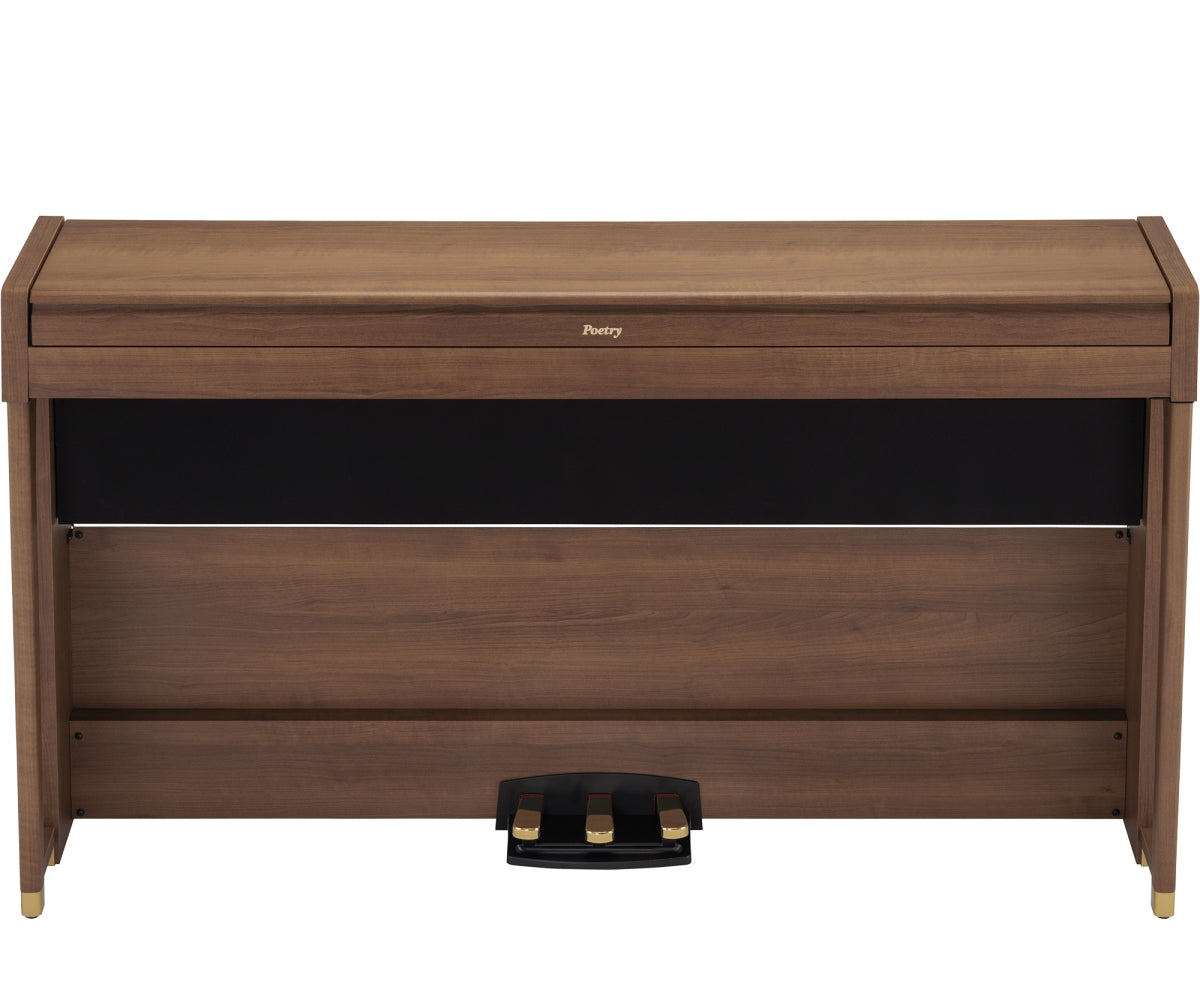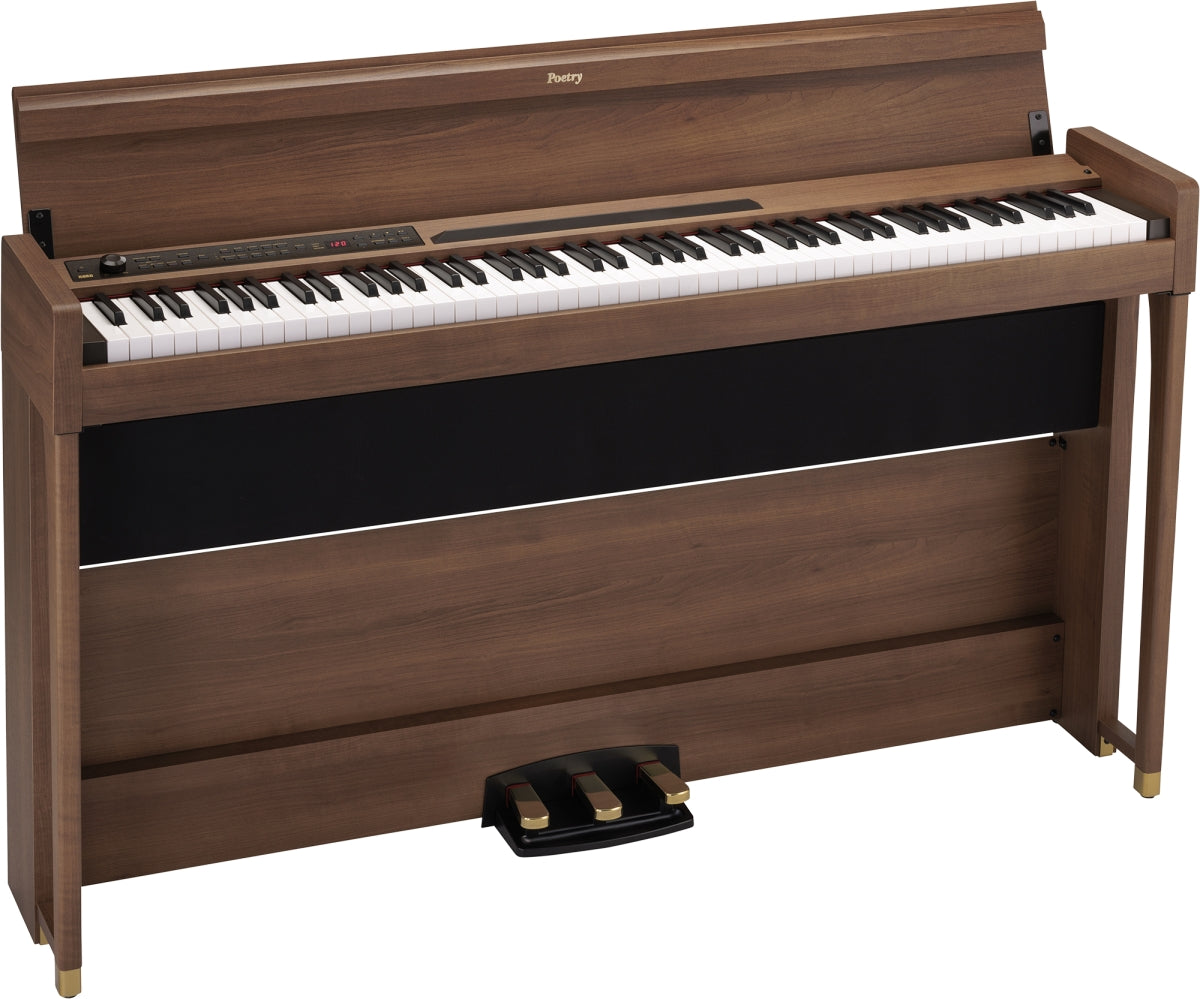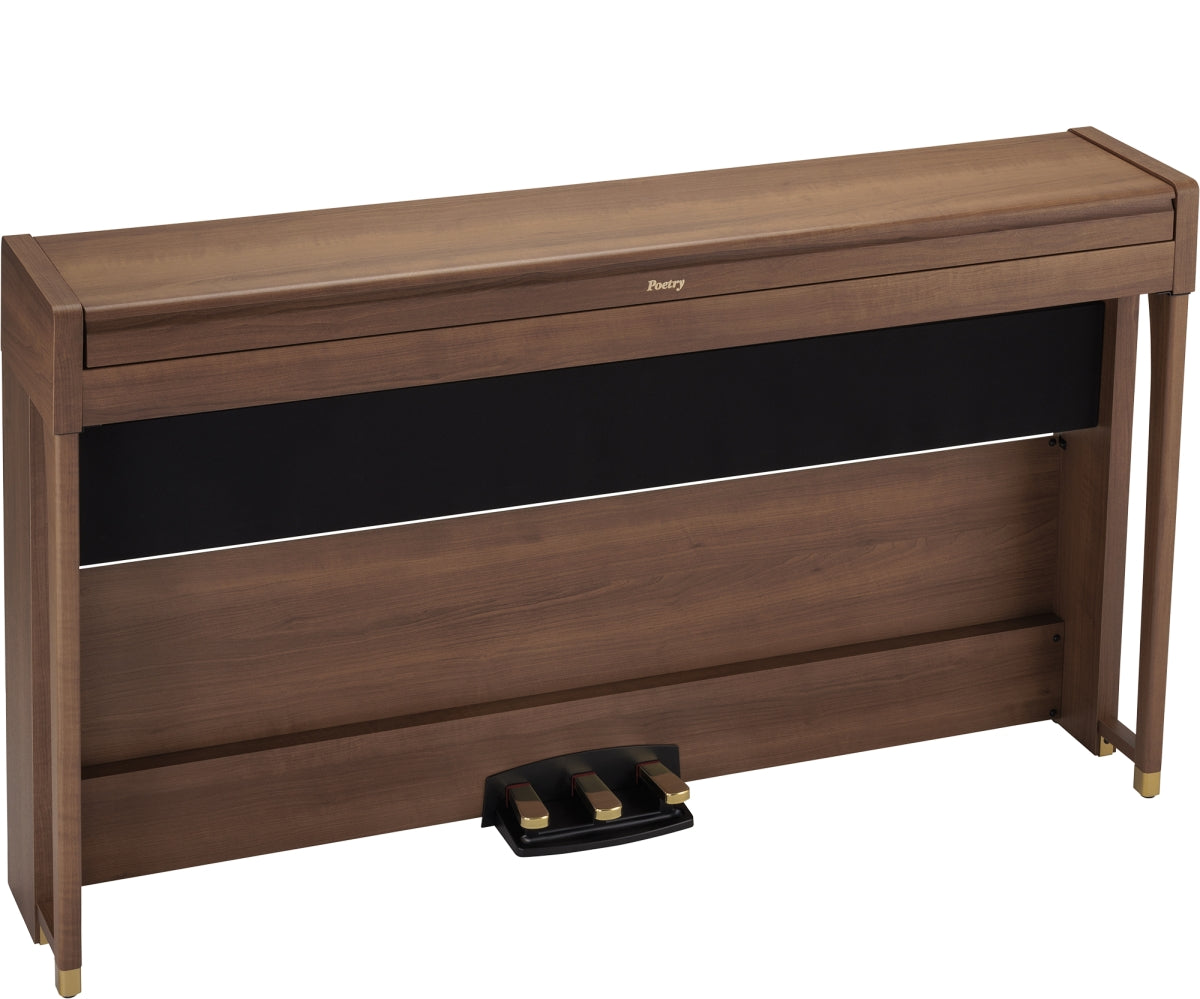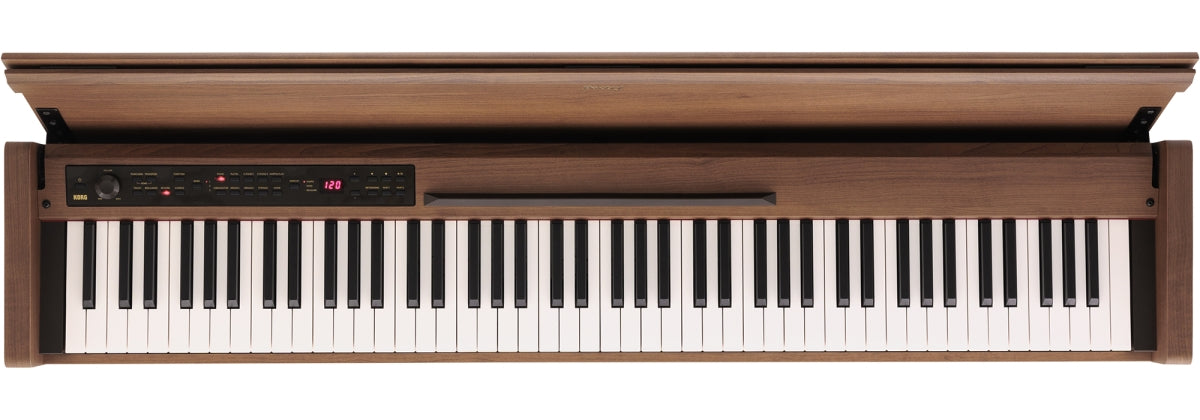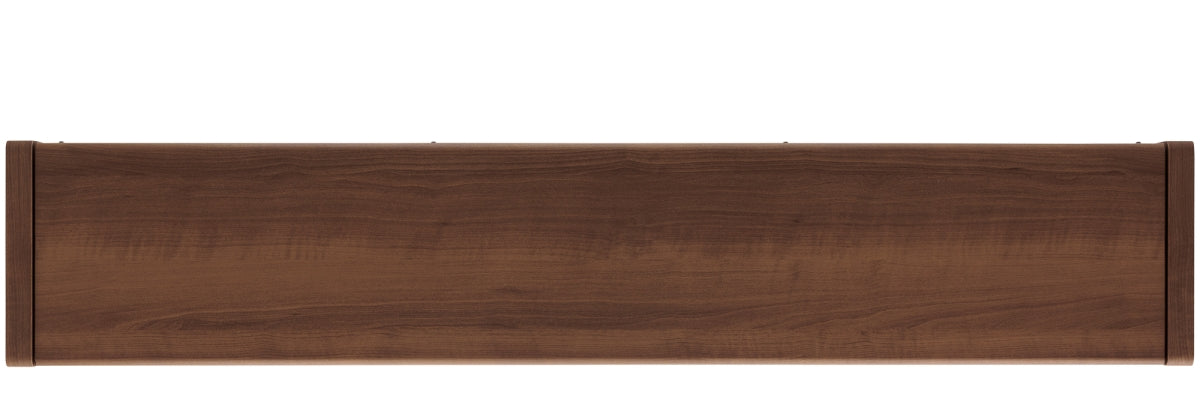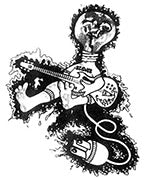Korg - Poetry Digital Piano
Couldn't load pickup availability
Description
The Piano For Lovers of Chopin
Introducing the Korg Poetry, a one-of-a-kind digital piano featuring two distinct piano tones associated with the legendary Frédéric Chopin. The first piano featured is the PLEYEL, Chopin's choice of piano, and the second is the contemporary exquisite Italian piano used in the prestigious Chopin Competition held every five years in Warsaw.
The PLEYEL tone, originating from the 19th century French piano, is a rare and coveted sound, with very few surviving Pleyel pianos to reference. The Korg Poetry digital piano, equipped with meticulously recorded and loaded high-quality sound samples of a vintage PLEYEL, brings the essence of that era into the contemporary world. Additionally, it offers the convenience of an electronic instrument, eliminating the need for regular tuning or maintenance.
- Two piano tones to encounter Chopin
- Embrace elegance with a stylish exterior adorned by beautiful woodgrains
- RH-3 keyboard with a comfortable touch - premium Japanese quality
- Half-damper compatible, with three pedals as standard
- Instantly record your performance with the two-part song recorder
- Features unique to digital pianos, such as a metronome, layers, and partner mode
- 50 Chopin masterpieces within Poetry
Two piano tones to encounter Chopin
The Korg Poetry is dedicated to the legendary Frédéric Chopin, a revered musician and celebrated classical composer and pianist who is internationally beloved. Poetry presents a unique opportunity for piano enthusiasts and Chopin lovers worldwide to experience his music in a new and captivating way.
Discover the symphony of heritage within Poetry, showcasing two distinguished piano sounds: the 1843 PLEYEL piano, a creation from Chopin's 33rd year, and the illustrious contemporary Italian concert grand piano, favored by many leading pianists, echoing its prestigious presence in the renowned international Chopin Competition and elsewhere on the global stage.
The PLEYEL3 sound features 80 keys that faithfully reflect the original instrument. Setting the pitch of this sound to 430 Hz reproduces the soundscape that resonated in Chopin's mind, faithfully recreating his vibrant musical world.
The contemporary Italian piano unveils a breathtaking, transparent, and profoundly expressive sound. In a contemporary rendition of the same piece, this piano captures the essence of a timeless composer's imagination. If Chopin were here today, surely he would find inspiration in crafting his soulful genius through the resounding notes of this modern masterpiece.
Embrace elegance with a stylish exterior adorned by beautiful woodgrains
Immerse yourself in the exquisite allure of the 'Poetic Brown' wood-grain exterior, a beautifully elegant design inspired by the gentle ambiance of Chopin. The gold-adorned pedals and toes contribute to a luxurious aesthetic, elevating the overall ambiance. With a slender depth of just 26 cm (excluding the anti-tipping bracket), the Poetry achieves a sleek profile, offering added convenience of a flat surface when the lid is closed.
RH-3 keyboard with a comfortable touch - premium Japanese quality
Experience the Real Weighted Hammer Action 3 (RH3) keyboard, meticulously designed to emulate the nuanced touch of a grand piano. Its weighted keys offer a heavier feel in the lower register and a lighter touch in the higher register, mirroring the authentic piano experience. Boasting high continuous stroke performance, the RH3 keyboard faithfully reproduces the intensity of notes, even in rapid passages, ensuring the performer's expressive power remains uncompromised. Notably eco-friendly, the keyboard eliminates the use of lead in the hammers. Further enhancing playability, it features key touch control, allowing players to customize note production across five levels (light, standard, heavy, steady, and constant) based on their touch strength, enabling a personalized and enjoyable playing experience.
The Poetry itself is also totally produced in Japan providing the assurance of the highest possible manufacturing quality.
Half-damper compatible, with three pedals as standard
Elevate your piano-playing experience with the standard inclusion of three indispensable pedals, mirroring the functionality of an acoustic piano. Seamlessly engage the damper, soft, and sostenuto pedals, essential for nuanced musical expression. Delve into even greater detail with the option for half-pedal usage, enhancing the subtlety and richness of your musical articulation.
Instantly record your performance with the two-part song recorder
Empower your musical journey with the two-part recorder feature, enabling you to record your performances, listen objectively, and enhance your playing. Capture the essence of your music by recording each hand separately, mimicking the approach of a piano piece. Alternatively, record your entire performance alongside a saved song. Take control of your practice with the ability to adjust the tempo of recorded user songs during playback, providing a dynamic tool for improvement and musical exploration.
Features unique to digital pianos, such as a metronome, layers, and partner mode
Enhance your practice sessions with the convenient metronome, easily toggled on and off with a single touch—ideal for lessons and refining your timing. Explore the immersive 'Layer Mode,' effortlessly combining two tones by pressing corresponding buttons simultaneously, enabling the harmonious blending of strings, vibraphone, and other instruments with the piano. Engage in collaborative play with the 'Partner Mode,' designed for two players to share the same register by dividing the keyboard into left and right sides. Whether for teachers and students or parents and children, this mode fosters shared musical experiences and enjoyable lessons.
Bluetooth audio support
Connect a Bluetooth device such as a smartphone to the Poetry and enjoy playing the piano along with your stored music or other audio. When you are not playing the piano, you can use the Poetry as a powerful Bluetooth speaker system.
50 Chopin masterpieces within Poetry
Immerse yourself in the world of Chopin with 50 masterpieces thoughtfully curated on the piano itself. Explore and compare the enchanting tones of the Italian piano and the PLEYEL tone, quickly and easily. Have beautiful background music played by Poetry! Additionally, indulge in the joy of playing using the 23 meticulously selected piano scores included, enabling you to relish both listening to and playing beautiful music the moment you acquire your own Poetry. To further captivate your musical senses, delight in 10 additional tone demo songs that showcase the instrument's diverse capabilities.
About Chopin
National Museum in Warsaw, Public domain, via Wikimedia Commons
Frédéric François Chopin
Frédéric François Chopin (1810-1849) was born in the village of Żelazowa Wola near Warsaw, Poland, to a French father, Mikołaj Chopin (1771-1844), and a Polish mother, Justyna Krzyżanowska (1782-1861). She was born in the village of Żelazowa Wola near Warsaw, Poland.
In his short life of only 39 years, Frédéric Chopin produced a large number of works using his unique compositional techniques and pianism, which were born from his exceptional sensibility. He has been called the "Poet of the Piano" because most of his works are piano pieces. It goes without saying that his lyrically beautiful melodies, colorful harmonies, and brilliant passages are unique in every way, touching the souls of music lovers everywhere.
It should be noted that Chopin's childhood musical education was extremely classical, which became the foundation for his later compositional activities. The influence of both Johann Sebastian Bach (1685-1750) and Wolfgang Amadeus Mozart (1756-1791), in particular, is evident in the compositional and tonal relationships, the counterpoint technique (a technique of layering multiple independent melodies harmonically while maintaining their independence) that appears in his works. In addition, the use of vocal techniques and fingerings, the composition style, tonal relationships, vocal techniques, fingering, and other aspects of Chopin's music are highlighted across all his works.
It is also important to understand the history of Poland during Chopin's lifetime.
In 1795, Poland was partitioned between Russia, Prussia (the predecessor of Germany), and Austria (the third partition), and remained off the world map for 123 years until the end of World War I in 1918.
In 1830, the year of the November Uprising, Chopin left Poland at the age of 20 with a sense of regret but finally found a place to work in Paris, France, where he would eventually establish his reputation as a composer and pianist.
In his works, Chopin projected the scenery and culture of his Polish homeland, and above all, his pride and identity as a Polish person, which he carried in his heart to distant lands.
Chopin and Pleyel Piano
“If I’m not feeling on top form, I prefer to play on an Érard, for its bright and ready-made tone. But if I feel alert, ready to make my fingers work without fatigue, then I prefer a Pleyel”. This statement by Chopin has become famous. In 1830s France, when Chopin began living in Paris, there were two major piano makers, Érard and Pleyel. While the Érard pianos were characterized by their gorgeous sound, rich volume, and easy to play functionality, the Pleyel pianos were soft and delicate, sensitive to even the slightest change in touch, and were said to be instruments that required a great deal of performing nerve. The variety of sounds produced by the Pleyel, drawn from its delicate touch control, was essential to Chopin's works, and it was his preferred musical partner.
About PLEYEL Piano
About the 1843 PLEYEL
The 1843 PLEYEL piano featured in Poetry is a remarkable piece crafted during Chopin's 33rd year. Transported to Japan in its original state from its home in France, meticulous restoration efforts were undertaken. Only consumable parts requiring replacement were sourced locally, while non-consumable components were specially ordered from France. The result is a faithful restoration, preserving the piano in a condition closely resembling its original state from 1843.
Features of PLEYEL
The PLEYEL piano carries a notable anecdote tied to Chopin's insistence on retaining the "single action" mechanism. Remarkably, PLEYEL adhered to this method for 14 years following Chopin's passing. In the context of pianos, "single action" implies that the hammers must return to their original position before striking the next key, posing challenges for executing rapid sequences of notes. In contrast, contemporary pianos feature a "double escapement" construction, allowing hammers to strike againy without fully returning to the keyboard. This innovation enables rapid and flamboyant playing, contributing to the finely crafted performance experience found in modern instruments.
Indeed, the evolution of pianos has been closely intertwined with changes in performance venues. In the mid-19th century and earlier, large concert halls as we know them today were not prevalent, and salon concerts were the prevailing norm. Paintings from that era often depict scenes of intimate salon settings where musicians, including Chopin, would perform. In these images, one can observe the closeness of the audience, with individuals leaning on the piano, creating an atmosphere of shared musical experiences. As pianos and musical culture evolved, the design and acoustics of concert halls became crucial in accommodating larger audiences while preserving the rich, resonant qualities of the piano in expansive spaces.
Indeed, before the advent of the piano, keyboard instruments like the harpsichord and pipe organ were prominent. The harpsichord, while capable of producing sufficient volume for orchestral use, posed challenges when played at lower pitches. Its inherently loud nature made it less suitable for the more intimate settings of salons. In response to this, the 'fortepiano,' which later evolved into the piano, was introduced.
The fortepiano addressed the volume issue by incorporating a hammer action mechanism, enabling it to produce both strong and soft notes. This innovation allowed musicians to play at varying volumes, a crucial development for performances in smaller venues like salons. During this period, the ability to control and play at a low volume was highly valued, marking a significant shift in the evolution of keyboard instruments.
The PLEYEL, distinguished by its thoughtful design, features a mute plate that serves to modulate the volume across registers. Specifically, it reduces volume in the middle and lower registers while allowing a crescendo towards the upper registers, fostering a harmonious musical balance. Even with these considerations, the PLEYEL is renowned for its capacity to articulate music with delicate expression, emphasizing nuanced subtleties rather than sheer fortissimo power. It stands as a testament to the artistry and craftsmanship dedicated to creating an instrument that resonates with beauty and musical sensitivity.
SPECS
Color
Poetic Brown (wood-grain pattern)
Keyboard
RH3 (Real weighted hammer action 3)
88Keys (A0-C8)
Touch Curves
Five available
Pitch Control
Transpose, Master tuning
Temperament
Three types
Sound Generation
Stereo PCM System
Polyphony
120 tones (max)
Sounds
30 sounds (10 x 3 banks)
Effects
Brilliance, Reverb, Chorus (3 levels each)
Recorder
Tow parts, maximum 14,000 notes(approximately 100 KB)
Demo songs
60(Sound Demo Song x 10, Choin’s Piano Songs x 50)
Metronome
Tempo, Time Signature, Accent, Sound and volume controls
Pedal
Damper*, Sostenuto, Soft*
(*:half-pedaling supported)
Connections
LINE INPUT, Headphones x 2, MIDI (IN,OUT), Pedal, SPEAKER
Controls
Power, VOLUME, PIANO SONG, TRANSPOSE, FUNCTION, TOUCH, BRILLIANCE, REVERB, CHORUS, BANK, Sound x 10 DISPLAY, +, -, METRONOME, Play/Pause, Stop, Record, PART1, PART2
Wireless Method
Bluetooth(A2DP Sink)
Speakers
10cm x 2
Amplification
25W x2
Power supply
DC 24V
Power consumption
18W
Dimensions (W x D x H)
1346 x 347 x 770 mm / 52.99 x 13.66 x 30.31 inches
1346 x 347 x 926 mm / 52.99 x 13.66 x 36.46 inches (with the key cover opened)
Weight
35kg / 77.16 Ibs. (including Stand)
Including Items
AC adapter, Dedicated Stand, Piano performance sheet music (23 Chopin pieces included)
Accessories
Piano Bench PC-300 (BR, BK,WH)
* All product names and company names are the trademarks or registered trademarks of their respective owners.
* Specifications and appearance are subject to change without notice for improvement.
* The color tone of the product may differ slightly from the actual color.

